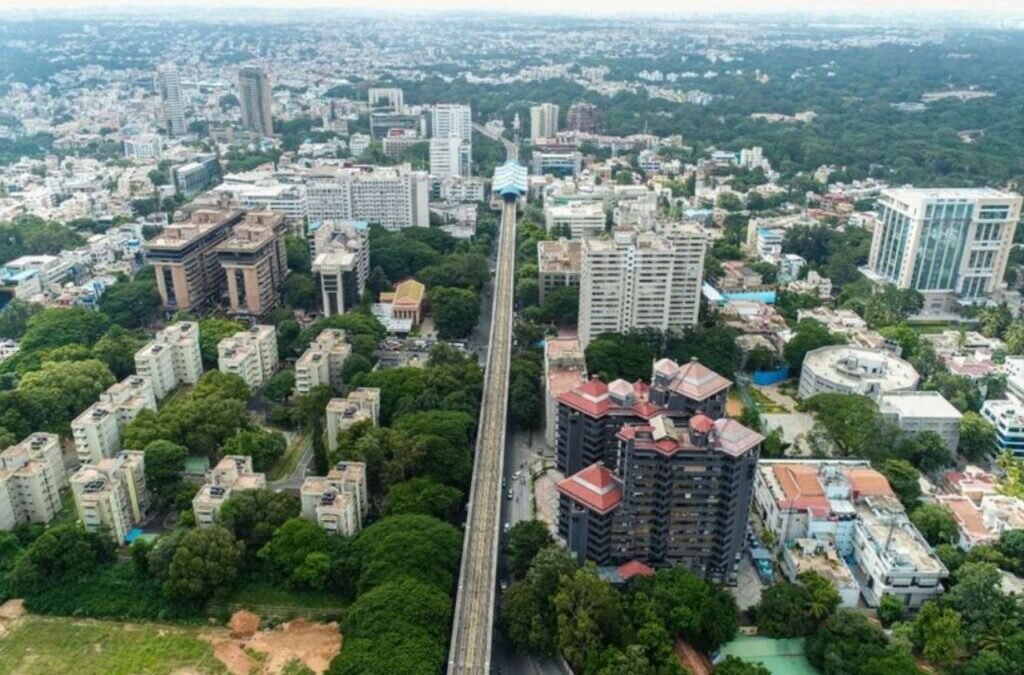Bengaluru, a city synonymous with startups and gridlocks, is finally seeing an active shift in its infrastructure landscape. With mega projects rolling out across road, rail and air connectivity, the Silicon Valley of India is bracing for a long-overdue transformation that promises to reshape how people live in the city. From high-speed suburban rail to an 18-km tunnel through the city’s belly, here’s a look at the most significant upcoming infrastructure projects in Bengaluru
1. Namma Metro Blue Line (Phase 2)
First on the agenda is the aggressive expansion of Namma Metro, which is set to redefine public transport in the city. Phase 2A, known as the Outer Ring Road (ORR) line, will connect Silk Board to KR Puram over 19 km with around 13 stations, dramatically easing congestion in one of the city’s most painful traffic stretches. Phase 2B extends the metro all the way to Kempegowda International Airport (KIA) via a 36.4 km corridor expected by 2026.
2. Namma Metro Red line (Phase 3)
Phase 3 of the Namma Metro is set to add over 80 km to Bengaluru’s rail network, significantly improving east-west and north-south connectivity across underserved areas. This phase includes the Sarjapur–Hebbal corridor (~36.6 km) under Phase 3A, and two additional lines—JP Nagar to Kempapura (~32 km) and Hosahalli to Kadabagere (~12.5 km)—under Phase 3, with approximately 30 new stations planned in total. The routes strategically connect tech corridors, residential zones and transit hubs, aiming to ease surface traffic and reduce commute times across the city’s growing periphery. Detailed project reports (DPRs) have been prepared, with execution expected to begin in phases after the completion of Phase 2B, estimated to be ready by 2028.
3. Bengaluru Suburban Rail Project (BSRP)
Complementing the metro is the ambitious Bengaluru Suburban Rail Project (BSRP), a 148-km network across four corridors- Sampige (KSR Bengaluru to Devanahalli, 41.4 km), Mallige (Benniganahalli to Chikkabanavara, 25.01 km), Parijaata (Kengeri to Whitefield, 35.52 km), and Kanaka (Heelalige to Rajanukunte, 46.24 km), with 64 stations in total. Targeted for phased rollout by 2026 and full commissioning by 2029, the BSRP aims to finally connect Bengaluru’s growing suburbs like Devanahalli, Yelahanka and Kengeri to the city core with affordable, fast rail transit. This promises to be a game-changer for daily commuters and the real estate market in satellite towns.
Also read: North Bengaluru Is Changing Fast — Could This be Bengaluru’s Next Real Estate Hotspot?
4. Underground Road (part of Brand Bengaluru Initiative)
In August of 2024, the Karnataka Cabinet gave the green signal for the 18-km twin-tube tunnel road between Hebbal and Silk Board. The Cabinet approved the twin-tube tunnel as it has been done in Mumbai and according to Indian Road Congress norms. This project is an 18-km twin-tube underground tunnel road connecting Hebbal to Silk Board, costing Rs 12,690 crore. Designed to streamline north-south traffic flow under the city, the project is set to begin in 2025. There’s also an east-west tunnel in planning, from KR Puram to Mysore Road, marking the beginning of a larger 170 km tunnel road network proposal aimed at easing surface congestion and reclaiming the city’s roads for smoother flow.
5. Satellite Town Ring Road (STRR) and Peripheral Ring Road (PRR)
Road infrastructure is receiving a parallel boost through mega expressways and ring roads. The Satellite Town Ring Road (STRR), spanning over 280 km, to connect 12 satellite towns and will integrate key growth nodes like Doddaballapur, Hosur, and Anekal into a single corridor. The first 80 km stretch of STRR was inaugurated by Prime Minister Narendra Modi on March 11, 2024. Another section of the project is expected to be made open to the public by March 2025. The entire project is expected to be completed by December 2025. However, considering the delays that may arise, the project may extend up to the year 2026-2027. Meanwhile, the long-stalled Peripheral Ring Road (PRR) has been revived as the Bangalore Business Corridor (BBC) with a 74-km, 8-lane expressway expected to be operational by 2027.
6. Hebbal-KIA Flyover
A dedicated flyover from Hebbal to KIA was proposed by DK Shivakumar, aimed at reducing the unpredictability of airport travel. In his meeting with Nitin Gadkari in Delhi, Shivakumar justified the flyover citing rapid urbanisation and growth of several industrial and commercial hubs around the airport, besides a sharp increase in passenger footfalls at KIA over the past few years.
7. Bengaluru Smart Infrastructure Limited (B-SMILE)
To fast-track all these developments, the Karnataka government has launched a special purpose vehicle (SPV) called B‑SMILE with ₹7,000 crore in funding to drive essential civic works like flyovers, underpasses, stormwater roads, and skywalks. B-SMILE refers to Bengaluru Smart Infrastructure Limited, a special-purpose vehicle (SPV) created by the Karnataka government to execute large-scale infrastructure projects in Bengaluru. It’s a dedicated company, fully owned by the government, but designed to attract private investment for projects like tunnel roads, elevated corridors, and white-topping of roads. The SPV was formed to address challenges like traffic congestion, slow project implementation, and overlapping authorities in Bengaluru’s urban planning.
In the short term, by 2025–27, commuters can expect major relief via metro corridors, suburban rail launches, and initial ring road access. By the end of the decade, the city is poised to enter a new era of well-connected urban living.
Written by Teertha Ravi
The post Upcoming Infrastructure Projects in Bengaluru That May Boost Property Prices; Here’s the List appeared first on Trade Brains.

